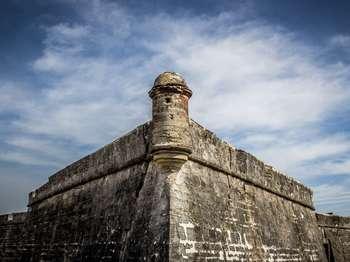Last updated: June 28, 2021
Place
Florida: Castillo de San Marcos National Monument

Historical/Interpretive Information/Exhibits, Wheelchair Accessible
The Castillo de San Marcos, in St. Augustine, Florida, serves as the oldest masonry fortification in the United States. Fortifications were built as a defensive wall or barrier to prevent potential attacks. During the height of the modern Civil Rights Movement, St. Augustine was selected in 1964 by Dr. Martin Luther King Jr. and the Southern Christian Leadership Conference (SCLC) as a target city for civil rights activities. Activists obtained permits from the National Park Service to use the Castillo as a meeting place for demonstrations.
In early 1963, local members of the NAACP developed a desegregation plan. NAACP leaders Fannie Fullerwood and Elizabeth Hawthorne wrote letters to then Vice President Lyndon B. Johnson. The letter urged Johnson to cancel his trip to dedicating a historic Spanish landmark. Johnson responded, stating that he would not participate in segregated functions. President John F. Kennedy was also the recipient of a letter from the local NAACP in May 1963, advocating against a federal grant of $350,000 intended for the Castillo’s Quadricentennial. All members of the Quadricentennial board were said to be white persons and were unsympathetic to issues facing the Black residents of St. Augustine.
On June 25, formal demonstrations began with Black teenagers of the NAACP's Youth Council picketing the local Woolworths and the St. Augustine Civic Center. The next day, 25 teenagers conducted sit-ins at Woolworths, McCrory's, and Service Drugs. White community members did not respond well to the peaceful demonstrations. Youth council leader Robert Hayling was depicted as a violent extremist, which garnered direct opposition from Mayor Joseph Shelley. By 1964, the Ku Klux Klan had begun a campaign of violence and intimidation. Shootings, clashes of violence during protests, and chaotic court cases nearly destroying the peaceful strides of the NAACP. Officials of the local NAACP realized that white militants were trying to seize the initiative. It was time to seek help from outside the city of St. Augustine.
In March of 1964, Robert Hayling and other Black local leaders met with the aides of Dr. Martin Luther King Jr. at the SCLC annual state meeting held in Orlando, Florida. The Black leaders from St. Augustine were able to convince Rev. C.T. Vivian to visit their town and see the conditions for himself. The SCLC watched events unfold in St. Augustine from July, and after visits with Vivian, they decided that their involvement could strengthen the community. The SCLC anticipated starting their St. Augustine campaign during the week of Easter, which gave white Northern college students a chance to participate. The inclusion of whites was an important strategy within itself, showing positive examples of integration. Hosea Williams coordinated the campaign, consisting of sit-ins, marches, meetings, and demonstrations. Each strategy had the common goal of placing a national microscope on years of oppression and convoluted race relations.
Several of the meetings were held on the grounds of Castillo de San Marcos, for which permits were obtained from the NPS. The national park grounds served as a safe assembly place for activists of all backgrounds. The police department and St. Johns County Sheriff’s Office failed to protect activists. Four of the local Sheriff's deputies were known active Ku Klux Klan members. On national park property, however, local law enforcement would not have authority over the activists. The successes of the movement in St. Augustine helped to convey the importance of passing a sweeping Civil Rights Act, and in July of that same year, The Civil Rights Act of 1964 was signed by President Lyndon B. Johnson.
The Castillo de San Marcos National Monument in Florida became part of the African American Civil Rights Network in June 2021.
The African American Civil Rights Network recognizes the civil rights movement in the United States and the sacrifices made by those who fought against discrimination and segregation. Created by the African American Civil Rights Act of 2017, and coordinated by the National Park Service, the Network tells the stories of the people, places, and events of the U.S. civil rights movement through a collection of public and private elements.
